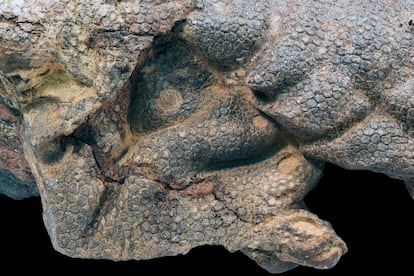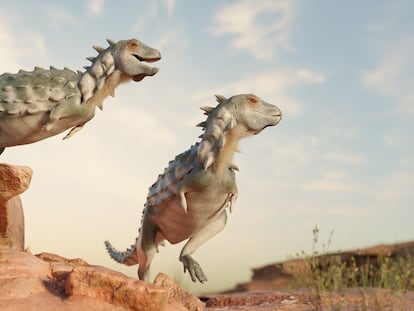The strange case of the mummified dinosaurs
The preservation of soft tissues is one of the forms of fossilization that most fascinates paleontologists due to all the information that these natural mummies reveal, as well as the challenge of explaining how they formed

In a universe of stone, a dinosaur mummy represents the nostalgia for the soft; the longing of the paleontologists who live in a blind world, forced to imagine the color, texture and entrails of the untouchable beings around which all their questions revolve. Until, every now and then, an answer of skin and bones emerges from the rocks — like the Borealopelta markmitchelli, a one-of-a-kind armored herbivore weighing 3,000 pounds and covered in thick spikes, which now lies like a sleeping gargoyle in a display case at the Royal Tyrrell Museum, in Canada.
That nodosaurid, described in 2017, is a mummy: the Tutankhamen of the dinosaurs. Its exceptional state of preservation after 112 million years makes it one of the most fascinating jewels of paleontology, one that allows researchers to study one of the most intriguing processes of fossilization: natural mummification.
One of the most widespread explanations for this phenomenon is rapid burial, which would have protected the body from scavengers and biological degradation. The Argentine paleontologist Juan Ignacio Canale, a researcher at the National Council for Scientific and Technical Research (CONICET) in that country, helps to understand this process: “We talk about a mummy when, in addition to the skeleton, there is a soft part preserved. It is a unique type of fossilization, beyond how exceptional it is in itself, because if the recycling of matter followed its natural, perfect course, fossils would not exist,” says the expert.
Mummification is the only process capable of protecting organs and bringing certainties to the scientific imagination. “What is interesting and special about it is that it preserves soft parts that tend to decompose very quickly, which provides a lot of information that would otherwise be subject to the paleontologists’ interpretation,” points out one of the fathers of the Meraxes gigas, before listing a series of unsolved mysteries in other types of fossilization: “What was the skin like? How was the scaling? Did they have feathers, filaments, hooves or claws?” The answers, the researcher assures, are inherently elusive.
It is as if we had never seen an elephant: facing its skeleton, we would not be able to know the shape of its trunk, or its length. We would even doubt the very existence of its unique nose. That, says Canale, is exactly what happens with the macrauchenia, which is similar to a guanaco from the Argentine Pampas region (it appears in the first Ice Age movie). Its nostrils were retracted into its skull, and its disparate recreations reflect such uncertainty. “We have ways of inferring some soft parts, but they are inferences. We don’t see them. In the case of mummies, we do. That is why they are so valuable, they attract so much attention and, even if it is difficult, every paleontologist wants to find one,” admits Canale.
Specific environmental conditions are necessary in order for natural mummification to be viable; it has to be a place where the existence of carrion-eaters is impossible and where the carcass can lie untouched for millions of years, sheltered from the sun and the erosion caused by wind and moving water. A natural sarcophagus, like the one that protected the Borealopelta, which — also helped by its particular armor — subsisted at a depth of more than 160 feet in the Canadian province of Alberta. This animal could have died near a watercourse that flowed into the extinct sea that reached much of North America during the Cretaceous; there it drifted until all the putrefied gases left its body, after which it sank and was slowly buried in the muddy, icy, suffocating bottom.

More than 110 million years later, researcher Donald Henderson, second author of the article that described the specimen, narrates the conditions that made the amazing encounter possible. “The carcass sank and hit the seabed hard, as we could see how the sedimentary layers below were deformed by the impact. Clouds of slime and mud settled on it, and mineral matter began to crystallize around the body shortly after it came to rest. These minerals formed something akin to an ancient Egyptian sarcophagus around the fossil. This kind of thick, dense and strong coffin prevented the carcass from being crushed (which happens to most fossils due to the weight of the rock that covers them) during the 112 million years that it was underground. In this way, the body remained buried in silence until it was hit by the bucket of a giant excavator [from the mining company that reported the discovery].”
The dense armor of the animal also played a key role. “It allowed it to remain intact as it floated on the surface of the water and was transported out to sea, making it difficult for large swimming scavengers, such as sharks and marine reptiles, to separate the shell from the body,” explains this Howard Carter of paleontology, who is also a curator of dinosaurs at the museum that exhibits the mummified nodosaurid. Finding such a rarity was baffling. At first, he and his team thought they were looking at a plesiosaur, one of the largest aquatic animals from the Cretaceous, common at the Alberta site. However, a few days later, a small rock with part of the fossil turned puzzlement into excitement: “Several minutes passed before we realized: it was a dinosaur! It was a great surprise, much celebrated, as all dinosaurs are terrestrial animals. We realized that very unusual conditions were necessary for its body to reach the sea intact.”
Exceptional conditions, such as those described by Henderson, allowed them to figure out intriguing details such as the insertion of the armor into the skin and its color. “When armored dinosaurs die and their bodies begin to decay, the armor falls off the body. There are only a couple of armored dinosaur fossils where we have a preserved record of how the armor was set on the body. However, the state of conservation of the in situ armor of these other ankylosaurs and nodosaurids is not as good as what we obtained with the Borealopelta,” explains Henderson. The conservation quality also confirmed a camouflage strategy. “We were able to identify keratin, a skin protein, and melanin, the pigment molecule. By mapping the concentrations of its residues, we could see that the animal had countershading on its back, darker flanks and a lighter color on the underside of the body. We see this today in all kinds of animals. The countershading was no surprise, but it was nice to see that idea confirmed in the fossil.”
An underground mystery
Another recent investigation challenges two long-standing ideas in the study of natural mummification, stating that rapid burial is not the only way that dinosaurs were able to undergo this form of fossilization and that scavengers are not always the enemies of that process. The individual who brings this into question has a duck bill and its name is Dakota; it is a 67 million-year-old herbivorous edmontosaurus found in 2006 in the Hell Greek Formation of North Dakota. Its delicate, peculiar characteristics have required more than 20,000 hours of cleaning and preparation; a task that continues to this day and that in each phase yields new theories and conclusions.
One of the latest theories, published in Plos One in 2022, describes how the animal could have been eaten by scavengers that disregarded its tough skin but punctured it, inadvertently creating vents for gases and access for microorganisms that also did not want to or could not swallow the skin, leaving the interior empty, ready for a process of deflation and desiccation due to the effect of the sun and the air. In this way, hardened, began the burial that allowed for the preservation of its skin and bones. Paleontologist Stephanie Drumheller, first author of the article and a researcher at the University of Tennessee, explains: “That is the subject of an ongoing research project: trying to find out what happened to Dakota after it was buried. Both the initial drying and the post-burial chemical alteration had to happen in the right way for a fossil like this to form.”

In the 2022 article, the scientist and her team emphasized that the supposed exceptional conditions necessary for natural mummification are, in fact, not so exceptional. “Modern decomposition studies have found multiple methods for natural mummies to form,” explains Drumheller. Her colleague and second author of the study, Clint Boyd, reveals — with reservations — some clues about what could have happened to this edmontosaur while it was underground: “We believe that the most important factor that contributed to the excellent preservation of Dakota occurred after burial, according to the chemistry of the groundwater that interacted with the specimen and fossilized it. I don’t want to say too much about that process right now because we’re still carrying out tests and our interpretations need to go through peer review. It seems that it was a very specific (and unusual) chemical process that preserved the specimen,” shares the paleontologist.
Even if the conditions for dinosaur mummification are not as exceptional as the Dakota article suggests, finding such fossils is still a rare occurrence. “The most unusual thing is that in the 12 years since the discovery of Borealopelta we haven’t had any other fossil dinosaurs around here, although now everyone in the mines knows what to look for,” admits Donald Henderson before leaving enthusiastically for his next scientific adventure; this time, to recover a large, unmummified sea lizard.
Sign up for our weekly newsletter to get more English-language news coverage from EL PAÍS USA Edition
Tu suscripción se está usando en otro dispositivo
¿Quieres añadir otro usuario a tu suscripción?
Si continúas leyendo en este dispositivo, no se podrá leer en el otro.
FlechaTu suscripción se está usando en otro dispositivo y solo puedes acceder a EL PAÍS desde un dispositivo a la vez.
Si quieres compartir tu cuenta, cambia tu suscripción a la modalidad Premium, así podrás añadir otro usuario. Cada uno accederá con su propia cuenta de email, lo que os permitirá personalizar vuestra experiencia en EL PAÍS.
¿Tienes una suscripción de empresa? Accede aquí para contratar más cuentas.
En el caso de no saber quién está usando tu cuenta, te recomendamos cambiar tu contraseña aquí.
Si decides continuar compartiendo tu cuenta, este mensaje se mostrará en tu dispositivo y en el de la otra persona que está usando tu cuenta de forma indefinida, afectando a tu experiencia de lectura. Puedes consultar aquí los términos y condiciones de la suscripción digital.
More information
Archived In
Últimas noticias
The latest scam on WhatsApp behind the legal dream: using immigration status as bait
Oil, gold and rare earth elements: the backdrop to US political tension with Venezuela
The open war against the oil ‘phantom fleet’
Russell Tovey: ‘I was advised many times not to come out, I don’t think there was many people who’d done that — and I feel really proud that I’m one of those that did’
Most viewed
- Families demand repatriation of bodies of Colombians who died in Ukraine: ‘This war is a slaughterhouse for foreigners’
- The low-cost creative revolution: How technology is making art accessible to everyone
- Liset Menéndez de la Prida, neuroscientist: ‘It’s not normal to constantly seek pleasure; it’s important to be bored, to be calm’
- Christian Louboutin: ‘Young people don’t want to be like their parents. And if their parents wear sneakers, they’re going to look for something else’
- ‘El Limones’ and the growing union disguise of Mexican organized crime










































